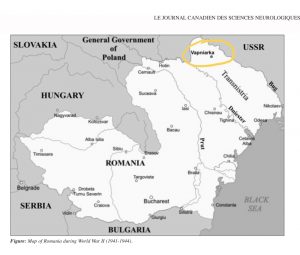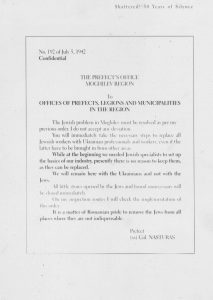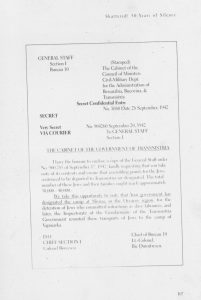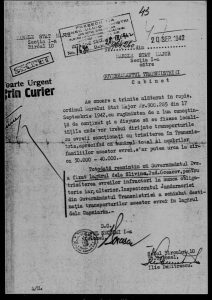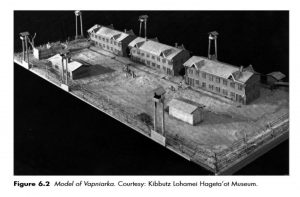“How do you know that we are interested in keeping you alive?” (Kessler in Enneking 2015, 7). This was asked by Sever Buradescu, a camp official of Vapniarka, a Romanian concentration camp in the region of Transnistria, now in modern Ukraine (Kessler in Enneking 2015, 7; Hirsch and Spitzer 2006, 138). He had been approached by a group of Vapniarka’s prisoners, who pleaded with him to provide the prisoners with supplies, and to remove the toxic cattle feed Lathyrus Sativus from their diets; he cruelly rebuffed them (Kessler in Enneking 2015, 7).
Vapniarka was established in 1941, as two decades of virulent antisemitism in Romanian and greater Europe cascaded into WWII and the Holocaust (Hirsch and Spitzer 2019, 13; Braham 1998, 12-13), culminating with the rise of military leader Ion Antonescu, and his vision of creating an ethnically “pure” Romania, without Jews (Solonari 2017). This sentiment is reflected in the telegram below.
The majority of the first contingent of Jews imprisoned in Vapniarka perished in a typhus epidemic that winter; the survivors were later executed (Benditer 1995).The second contingent of Jews, however, was different. In September 1942, a group of Jewish prisoners “who [had] committed infractions as slave labourers” arrived in Vapniarka; the telegram describing so can be found below (From The Nizkor Project). Essentially, of the 1000-1200 new prisoners, the “majority…had communist views” (Benditer 1995; Degeratu 2015, 30-31).
Upon their arrival in the camp, the prisoners were subjected to horrendous living conditions: barracks in disrepair, a paucity of hygienic supplies, and a daily regime of “starvation, daily incarcerations, beatings, and diabolical methods of torture,” carried out by Ion Murgescu, a camp commandant (Shapiro 2013, 119; Benditer 1995).
Sadly, conditions in Vapniarka became worse. By “November 13, 1942, G. Alexianu, the Governor of Transnistria, complained to the Assembly of Ministers that he had experienced enough problems in supplying the army with food, without having to also satisfy “the needs of the Jewish Communist deportees interned in the camp” ” (Alexianu in Benditer 1995).
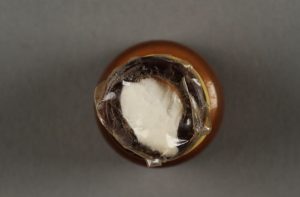
“ Seed, possibly fodder pea (sativa), collected by Dr. Arthur Kessler at Vapniarka camp in Transnistria, where he worked and was interned” (From “Seed Housed Inside Glass Jar”).
As such, upon recommendation from a Gestapo representative, the Romanians, “drawing on stocks of animal feed abandoned by Soviet forces in 1941…fed the prisoners a diet that consisted primarily of a toxic fodder pea (Lathyrus sativus)” (Benditer 1995; Shapiro 2013, 119-20; emphasis in original from Shapiro).
The prisoners’ daily rations typically consisted of: “200 grams of bread, 400 grams of fodder peas, and 15 grams of salt, plus 500 grams of wood to feed the stoves;” occasionally, some oil, horse meat, or vegetables were also provided (Shapiro 2013, 129).
By December 1942, however, a mysterious disease started afflicting Vapniarka’s prisoners (Kessler in Enneking 2015, 6). As Dr. Arthur Kessler, a Jewish physician interned in Vapniarka noted, “After 3 days [of being in the infirmary], Solomowicz is unable, even with crutches, to reach the latrine or bucket. His legs are spastic, they cross over when he attempts to walk (scissor gait)” (Kessler in Enneking 2015, 6). At this moment, Kessler and his medical team were unaware of the disease’s cause, yet through copious note taking and study, Kessler realized that only the prisoners were afflicted, which they later discovered was called neurolathyrism, and that it was likely caused by the forced consumption of the cattle fodder (Kessler in Enneking 2015, 9; Garfinkle, Andermann, and Shevell 2011, 842).
Slowly, the situation worsened. As Kessler described: “As Kessler described: “there [were] already 120 completely lame and another 1000 on their way” (Kessler in Enneking 2015, 6). It was at this point the delegation, led by Kessler, approached Buradescu and were rebuffed.
However, all was not lost. On December 31, 1942, Ion Antonescu (yes, that Ion Antonescu), made the “decision to permit prisoners at Vapniarka to be assigned to forced labor outside the camp. Internee accounts record this as a positive development: it permitted them…to smuggle food into the camp at the end of the work day” (Shapiro 2013, 129). This was a turning point that allowed Jews to begin a prolonged resistance to the forced consumption of L. Sativus. “People were advised to refuse the daily rations that were made available to them. At the same time, an appeal was made to the wealthier communities to share the little food they had saved…. Similarly, those who worked outside the camp…brought back and shared some of the food” (Benditer 1995). This food was shared around the camp, allowing the prisoners to avoid consuming L. Sativus for nearly three weeks (Benditer 1995)! The climax? The prisoners blocked off the entrance to the camp, preventing the Romanians from bringing more fodder inside (Benditer 1995; Garfinkle, Andermann and Shevell 2011, 842). By January 23, 1943, L. Sativus was removed from the prisoners’ diets (Benditer 1995).
By then, the Vapniarka horror had begun to come to a close. “In early 1943…the Romanian Ministry of the Interior established a committee to repatriate those Jews sent to Camp Vapniarka for “unjustifiable” reasons” (Garfinkle, Andermann, and Shevell 2011, 842). As a result, in May 1943, about 430 prisoners were permitted to leave Vapniarka, although they were forced to live in specific ghettos in Transnistria (Garfinkle, Andermann, and Shevell 2011, 842). “These were repatriated to Romania after several months, in December 1943 and January 1944” (Degeratu 2015, 33).
By late 1943, Vapniarka was closed, and about 565 internees were deported to the camp at Grosulovo, where, on multiple occasions, Romanian officer Savin Motora saved them from execution (Benditer 1995). They were later re-deported to the Târgu-Jim camp, where they were released on August 24, 1944 (Degeratu 2015, 37).
Sadly, in October 1943, a smaller group of prisoners (54) was deported to the Ribnistia prison, where all but three were massacred by German SS troops (Benditer 1995).
Ultimately, 600-800 prisoners of Vapniarka were estimated to have experienced symptoms of neurolathyrism; at least 120 were permanently disabled, and at least ten prisoners lost their lives as direct casualties of L. Sativus (Garfinkle, Andermann, and Shevell 2011, 842; Hirsch and Spitzer 2006, 149).
The Holocaust desecrated the Romanian Jewish community. Radu Ioanid noted that, “270,000 Jews died in Romania” (Ioanid 2000, xxi). And in Transnistria, “less than half of the roughly 140,000 Jews who were deported…survived” (Garfinkle, Andermann, and Shevell 2011, 842).

